看NRT,看PYTORCH
def run(data_type, existing_model_name = None):
modules, consts, options = init_modules(data_type)
def init_modules(data_type):
options = {}
options["is_predicting"] = False #Traing时候填false,predicting填true
print ("is_predicting: ", options["is_predicting"], ", data = " + data_type)
options["is_unicode"] = True
print ("loading...") # 读取准备好的数据文件
all_data = pickle.load(open("./data/data_"+ data_type + ".pkl", "rb"))
‘‘‘
x_raw_train/dev/test: [[0,0,5 [‘nice‘, ‘app‘], [‘nice‘,‘app‘...]], [...]]
old_dic: { ‘nice‘: 1569, ...} len=24177
dic: {‘nice‘:1569 ...} len=6468 (经过threshold筛选)
hfw: [‘<unk>‘, ‘<eos>‘, ‘the‘....]
i2w: {0: ‘nice‘, 1: ‘app‘ ...} w2i: {‘nice‘: 0, ‘app‘: 1 ...}
w2w: {‘nice‘: ‘nice‘, ‘sy‘: <unk>, ...}
w2idf: {‘nice‘: 1.1639902059516225, ...}
i2user: {0: 16672, ...} user2i: {16672: 0, ... }(username)
i2item/ item2i (itemname)
user2w: {0: {0, 1, 2, 3, 4, 6467}, 1: {...}, ...} 所有同一个user的对应评论
item2w: {0: {0, 1, 2, .... 1333, 1902, 6467}, 1:{...}, ... } 所有同一个item对应的评论
‘‘‘
[x_raw_train, x_raw_dev, x_raw_test, old_dic, dic, hfw, i2w, w2i, w2w, w2idf, i2user, user2i, i2item, item2i, user2w, item2w] = all_data
consts = {}
consts["num_user"] = len(user2i)
consts["num_item"] = len(item2i)
consts["dict_size"] = len(dic)
consts["hfw_dict_size"] = len(hfw)
consts["lvt_dict_size"] = LVT_DICT_SIZE #6468
consts["len_y"] = LEN_Y # 35 + 1
consts["dim_x"] = DIM_X # 300 根据论文上写的
consts["dim_w"] = DIM_W # 300
consts["dim_h"] = DIM_H # 400
consts["dim_r"] = DIM_RATING # 6
consts["max_len_predict"] = consts["len_y"]
consts["min_len_predict"] = 1
consts["batch_size"] = 200
consts["test_batch_size"] = 1
consts["test_samples"] = 2000
consts["beam_size"] = 5
consts["lr"] = 1.
consts["print_size"] = 2 #400 2 for demo
print ("#train = ", len(x_raw_train), ", #dev = ", len(x_raw_dev), ", #test = ", len(x_raw_test))
print ("#user = ", consts["num_user"], ", #item = ", consts["num_item"])
print ("#dic = ", consts["dict_size"], ", #hfw = ", consts["hfw_dict_size"])
modules = {}
modules["all_data"] = all_data
modules["hfw"] = hfw
modules["w2i"] = w2i
modules["i2w"] = i2w
modules["w2w"] = w2w
modules["u2ws"] = user2w
modules["i2ws"] = item2w
modules["w2idf"] = w2idf
modules["eos_emb"] = modules["w2i"][W_EOS]
modules["unk_emb"] = modules["w2i"][W_UNK]
modules["optimizer"] = "adadelta"
modules["stopwords"] = datar.load_stopwords("./data/stopwords_en.txt")
return modules, consts, options
print ("compiling...")
model = NeuralRecsys(modules, consts, options)
if training_model:
print ("training......")
[x_raw_train, x_raw_dev, x_raw_test, old_dic, dic, hfw, i2w, w2i, w2w, w2idf, i2user, user2i, i2item, item2i, user2w, item2w] = modules["all_data"]
for epoch in range(0, 50):
if epoch > 2:
consts["lr"] = 0.1
start = time.time()
# [[随机排序的index], [随机的index], []...]
batch_list = datar.get_batch_index(len(x_raw_train), consts["batch_size"])
error = 0
error_i = 0
error_rmse = 0
e_nll = 0
e_nllu = 0
e_nlli = 0
e_cce = 0
e_mae = 0
e_l2n = 0
for batch_index in batch_list:
local_batch_size = len(batch_index)
#提取出当前batch所需要的traindata
batch_raw = [x_raw_train[bxi] for bxi in batch_index]
load_time = time.time()
XU, XI, Y_r, Y_r_vec, Dict_lvt, Y_rev_tf, Y_rev_mark, Y_sum_idx, Y_sum_mark, Y_sum_lvt, lvt_i2i = datar.get_batch_data(batch_raw, consts, options, modules)
def get_batch_data(raw_x, consts, options, modules):
batch_size = len(raw_x)
hfw = modules["hfw"]
w2i = modules["w2i"]
i2w = modules["i2w"]
w2w = modules["w2w"]
w2idf = modules["w2idf"]
u2ws = modules["u2ws"]
i2ws = modules["i2ws"]
len_y = consts["len_y"]
lvt_dict_size = consts["lvt_dict_size"]
xu = np.zeros(batch_size, dtype = "int64") # 记录一组userid
xi = np.zeros(batch_size, dtype = "int64") # 记录一组itemid
yr = np.zeros(batch_size, dtype = theano.config.floatX) #记录一组rating
# one_hot encode DIM_RATING: 0--5 = 6
yr_vec = np.zeros((batch_size, DIM_RATING) , dtype = theano.config.floatX)
y_review_mark = np.zeros((batch_size, lvt_dict_size) , dtype = theano.config.floatX)
y_review_tf = np.zeros((batch_size, lvt_dict_size) , dtype = theano.config.floatX)
y_summary_index = np.zeros((len_y, batch_size, 1) , dtype = "int64")
y_summary_mark = np.zeros((len_y, batch_size) , dtype = theano.config.floatX)
y_summary_lvt = np.zeros((len_y, batch_size, 1) , dtype = "int64")
dic_review_words = {}
w2i_review_words = {}
lst_review_words = []
lvt_user_item = {w2i[W_EOS]}
lvt_i2i = {}
for i in range(batch_size):
uid, iid, r, summary, review = raw_x[i]
xu[i] = uid
xi[i] = iid
yr[i] = r
yr_vec[i, int(r)] = 1.
lvt_user_item |= u2ws[uid] | i2ws[iid] #将所有的review词整合到一起
if len(summary) > len_y: # 最大长度
summary = summary[0:len_y-1] + [W_EOS]
for wi in range(len(summary)):
w = summary[wi]
w = w2w[w]
if w in dic_review_words:
dic_review_words[w] += 1 #记录每个词出现的次数
else:
w2i_review_words[w] = len(dic_review_words) #生成当前batch的word2id
dic_review_words[w] = 1
lst_review_words.append(w2i[w])
y_summary_index[wi, i, 0] = w2i[w] #?
y_summary_lvt[wi, i, 0] = w2i_review_words[w] #?
y_summary_mark[wi, i] = 1 #?
for w in review:
w = w2w[w]
if w in dic_review_words:
dic_review_words[w] += 1
else:
w2i_review_words[w] = len(dic_review_words)
dic_review_words[w] = 1
lst_review_words.append(w2i[w])
y_review_mark[i, w2i_review_words[w]] = 1
y_review_tf[i, w2i_review_words[w]] += 1 #w2idf[w]
y_review_tf /= 10.
# 补充当前batch未出现过的词,dic=0
if len(dic_review_words) < lvt_dict_size:
for rd_hfw in hfw:
if rd_hfw not in dic_review_words:
w2i_review_words[rd_hfw] = len(dic_review_words)
dic_review_words[rd_hfw] = 0
lst_review_words.append(w2i[rd_hfw])
if len(dic_review_words) == lvt_dict_size:
break
else:
print ("!!!!!!!!!!!!")
for i in range(len(lst_review_words)):
lvt_i2i[i] = lst_review_words[i]
assert len(dic_review_words) == lvt_dict_size
assert len(lst_review_words) == lvt_dict_size
if options["is_predicting"]:
lvt_i2i = {}
lst_review_words = list(lvt_user_item)
for i in range(len(lst_review_words)):
lvt_i2i[i] = lst_review_words[i]
lst_review_words = np.asarray(lst_review_words)
return xu, xi, yr, yr_vec, lst_review_words, y_review_tf, y_review_mark, y_summary_index, y_summary_mark, y_summary_lvt, lvt_i2i
cost, mse, nll, nllu, nlli, cce, mae, l2n, rat_pred, sum_pred = model.train(XU, XI, Y_r, Y_r_vec, Dict_lvt, Y_rev_tf, Y_rev_mark, Y_sum_idx, Y_sum_mark, Y_sum_lvt, local_batch_size, consts["lr"])
#print cost, mse, nll, cce, l2n
error += cost
error_rmse += math.sqrt(mse)
e_nll += nll
e_nllu += nllu
e_nlli += nlli
e_cce += cce
e_mae += mae
e_l2n += l2n
error_i += 1
if error_i % consts["print_size"] == 0:
print ("epoch=", epoch, ", Error now = ", error / error_i, ", ",)
print ("RMSE now = ", error_rmse / error_i, ", ",)
print ("MAE now = ", e_mae / error_i, ", ",)
print ("NLL now = ", e_nll / error_i, ", ",)
print ("NLLu now = ", e_nllu / error_i, ", ",)
print ("NLLi now = ", e_nlli / error_i, ", ",)
print ("CCE now = ", e_cce / error_i, ", ",)
print ("L2 now = ", e_l2n / error_i, ", ",)
print (error_i, "/", len(batch_list), "time=", time.time()-start)
save_model("./model/m_" + data_type + "." + str(epoch) + "." + str(int(error_i / consts["print_size"])), model)
print_sent_dec(sum_pred, Y_sum_idx, Y_sum_mark, modules, consts, options, lvt_i2i)
save_model("./model/m_" + data_type + "." + str(epoch), model)
#print_sent_dec(sum_pred, Y_sum_idx, Y_sum_mark, modules, consts, options, lvt_i2i)
print ("epoch=", epoch, ", Error = ", error / len(batch_list),)
print (", RMSE = ", error_rmse / len(batch_list), ", time=", time.time()-start)
为什么出来全都是unk啊
Theano是一个Python库,你可以定义,优化,评价数学表达式,尤其是多维数组 (numpy.ndarray)
最接近Theano的Python包是sympy,Theano比sympy更专注于张量表达式,并且有更多的机制来编译,
class NeuralRecsys(object):
def __init__(self, modules, consts, options):
self.is_predicting = options["is_predicting"]
self.optimizer = modules["optimizer"]
# import theano.tensor as T
# 各种建立
self.xu = T.vector("xu", dtype = "int64")
self.xi = T.vector("xi", dtype = "int64")
self.y_rating = T.vector("y_rating")
self.lvt_dict = T.lvector("lvt_dict")
self.y_rev_mark = T.matrix("y_rev_mark")
self.y_rev_tf = T.matrix("y_rev_tf")
self.y_rat_vec = T.matrix("y_rat_vec")
self.y_sum_idx = T.tensor3("y_sum_idx", dtype = "int64")
self.y_sum_mark = T.matrix("y_sum_mark")
if not self.is_predicting:
self.y_sum_lvt = T.tensor3("y_sum_lvt", dtype = "int64")
self.lr = T.scalar("lr")
self.batch_size = T.iscalar("batch_size")
self.num_user = consts["num_user"]
self.num_item = consts["num_item"]
self.dict_size = consts["hfw_dict_size"]
self.lvt_dict_size = consts["lvt_dict_size"]
self.dim_x = consts["dim_x"]
self.dim_w = consts["dim_w"]
self.dim_h = consts["dim_h"]
self.dim_r = consts["dim_r"]
self.len_y = consts["len_y"]
self.params = []
self.sub_params = []
self.define_layers(modules, consts, options)
if not self.is_predicting:
self.define_train_funcs(modules, consts, options)
‘‘‘
The number of layers for the rating regression model is 4, and for the tips generation model is 1.
‘‘‘
def define_layers(self, modules, consts, options):
# init_weights 来自utils_pg.py
self.emb_u = init_weights((self.num_user, self.dim_x), "emb_u", sample = "normal")
self.emb_i = init_weights((self.num_item, self.dim_x), "emb_i", sample = "normal")
self.params += [self.emb_u, self.emb_i]
xu_flat = self.xu.flatten() # 向量吗???
xi_flat = self.xi.flatten()
xu_emb = self.emb_u[xu_flat, :] # 这些是什么意思哇
xu_emb = T.reshape(xu_emb, (self.batch_size, self.dim_x))
xi_emb = self.emb_i[xi_flat, :]
xi_emb = T.reshape(xi_emb, (self.batch_size, self.dim_x))
## user-doc
self.W_ud_uh = init_weights((self.dim_x, self.dim_h), "W_ud_uh")
self.b_ud_uh = init_bias(self.dim_h, "b_ud_uh")
self.W_ud_hd = init_weights((self.dim_h, self.dict_size), "W_ud_hd")
self.b_ud_hd = init_bias(self.dict_size, "b_ud_hd")
self.sub_W_ud_hd = self.W_ud_hd[:, self.lvt_dict]
self.sub_b_ud_hd = self.b_ud_hd[self.lvt_dict]
self.params += [self.W_ud_uh, self.b_ud_uh]
self.sub_params = [(self.W_ud_hd, self.sub_W_ud_hd, (self.dim_h, self.lvt_dict_size)),
(self.b_ud_hd, self.sub_b_ud_hd, (self.lvt_dict_size,))]
h_ru = T.nnet.sigmoid(T.dot(xu_emb, self.W_ud_uh) + self.b_ud_uh)
self.W_ud_uh2 = init_weights((self.dim_h, self.dim_h), "W_ud_uh2")
self.b_ud_uh2 = init_bias(self.dim_h, "b_ud_uh2")
self.params += [self.W_ud_uh2, self.b_ud_uh2]
h_ru2 = T.nnet.sigmoid(T.dot(h_ru, self.W_ud_uh2) + self.b_ud_uh2) ###
self.W_ud_uh3 = init_weights((self.dim_h, self.dim_h), "W_ud_uh3")
self.b_ud_uh3 = init_bias(self.dim_h, "b_ud_uh3")
self.params += [self.W_ud_uh3, self.b_ud_uh3]
h_ru3 = T.nnet.sigmoid(T.dot(h_ru2, self.W_ud_uh3) + self.b_ud_uh3) ##############
## item-doc
self.W_id_ih = init_weights((self.dim_x, self.dim_h), "W_id_ih")
self.b_id_ih = init_bias(self.dim_h, "b_id_ih")
self.W_id_hd = init_weights((self.dim_h, self.dict_size), "W_id_hd")
self.b_id_hd = init_bias(self.dict_size, "b_id_hd")
self.sub_W_id_hd = self.W_id_hd[:, self.lvt_dict]
self.sub_b_id_hd = self.b_id_hd[self.lvt_dict]
self.params += [self.W_id_ih, self.b_id_ih]
self.sub_params += [(self.W_id_hd, self.sub_W_id_hd, (self.dim_h, self.lvt_dict_size)),
(self.b_id_hd, self.sub_b_id_hd, (self.lvt_dict_size,))]
h_ri = T.nnet.sigmoid(T.dot(xi_emb, self.W_id_ih) + self.b_id_ih)
self.W_id_ih2 = init_weights((self.dim_h, self.dim_h), "W_id_ih2")
self.b_id_ih2 = init_bias(self.dim_h, "b_id_ih2")
self.params += [self.W_id_ih2, self.b_id_ih2]
h_ri2 = T.nnet.sigmoid(T.dot(h_ri, self.W_id_ih2) + self.b_id_ih2) ###
self.W_id_ih3 = init_weights((self.dim_h, self.dim_h), "W_id_ih3")
self.b_id_ih3 = init_bias(self.dim_h, "b_id_ih3")
self.params += [self.W_id_ih3, self.b_id_ih3]
h_ri3 = T.nnet.sigmoid(T.dot(h_ri2, self.W_id_ih3) + self.b_id_ih3) #####
## user-item-doc
self.W_uid_uh = init_weights((self.dim_x, self.dim_h), "W_uid_uh")
self.W_uid_ih = init_weights((self.dim_x, self.dim_h), "W_uid_ih")
self.b_uid_uih = init_bias(self.dim_h, "b_uid_uih")
self.W_uid_hd = init_weights((self.dim_h, self.dict_size), "W_uid_hd")
self.b_uid_hd = init_bias(self.dict_size, "b_uid_hd")
self.sub_W_uid_hd = self.W_uid_hd[:, self.lvt_dict]
self.sub_b_uid_hd = self.b_uid_hd[self.lvt_dict]
self.params += [self.W_uid_uh, self.W_uid_ih, self.b_uid_uih]
self.sub_params += [(self.W_uid_hd, self.sub_W_uid_hd, (self.dim_h, self.lvt_dict_size)),
(self.b_uid_hd, self.sub_b_uid_hd, (self.lvt_dict_size,))]
h_rui = T.nnet.sigmoid(T.dot(xu_emb, self.W_uid_uh) + T.dot(xi_emb, self.W_uid_ih) + self.b_uid_uih)
self.W_uid_uih2 = init_weights((self.dim_h, self.dim_h), "W_uid_uih2")
self.b_uid_uih2 = init_bias(self.dim_h, "b_uid_uih2")
self.params += [self.W_uid_uih2, self.b_uid_uih2]
h_rui2 = T.nnet.sigmoid(T.dot(h_rui, self.W_uid_uih2) + self.b_uid_uih2) ###
self.W_uid_uih3 = init_weights((self.dim_h, self.dim_h), "W_uid_uih3")
self.b_uid_uih3 = init_bias(self.dim_h, "b_uid_uih3")
self.params += [self.W_uid_uih3, self.b_uid_uih3]
h_rui3 = T.nnet.sigmoid(T.dot(h_rui2, self.W_uid_uih3) + self.b_uid_uih3) #####
# --------------------这上面的都是些什么玩意?-------------------------------
# predict 1: rating
self.W_r_uh = init_weights((self.dim_x, self.dim_h), "W_r_uh")
self.W_r_ih = init_weights((self.dim_x, self.dim_h), "W_r_ih")
self.W_r_uih = init_weights((self.dim_x, self.dim_h), "W_r_uih")
self.b_r_uih = init_bias(self.dim_h, "b_r_uih")
self.W_r_hr = init_weights((self.dim_h, 1), "W_r_hr")
self.W_r_ur = init_weights((self.dim_x, 1), "W_r_ur")
self.W_r_ir = init_weights((self.dim_x, 1), "W_r_ir")
self.b_r_hr = init_bias(1, "b_r_hr")
self.params += [self.W_r_uh, self.W_r_ih, self.W_r_uih, self.b_r_uih, self.W_r_hr, self.b_r_hr, self.W_r_ur, self.W_r_ir]
# 公式(3)
h_r = T.nnet.sigmoid(T.dot(xu_emb, self.W_r_uh) + T.dot(xi_emb, self.W_r_ih) + T.dot(xu_emb * xi_emb, self.W_r_uih) + self.b_r_uih)
self.W_r_hh2 = init_weights((self.dim_h, self.dim_h), "W_r_hh2")
self.b_r_hh2 = init_bias(self.dim_h, "b_r_hh2")
self.params += [self.W_r_hh2, self.b_r_hh2]
# 公式(5)多层
h_r2 = T.nnet.sigmoid(T.dot(h_r, self.W_r_hh2) + self.b_r_hh2) ###
self.W_r_hh3 = init_weights((self.dim_h, self.dim_h), "W_r_hh3")
self.b_r_hh3 = init_bias(self.dim_h, "b_r_hh3")
self.params += [self.W_r_hh3, self.b_r_hh3]
# 公式(5)
h_r3 = T.nnet.sigmoid(T.dot(h_r2, self.W_r_hh3) + self.b_r_hh3) #####
## merge them
self.review_i = T.nnet.softmax(T.dot(h_ri3, self.sub_W_id_hd) + self.sub_b_id_hd)
self.review_u = T.nnet.softmax(T.dot(h_ru3, self.sub_W_ud_hd) + self.sub_b_ud_hd)
self.review = T.nnet.softmax(T.dot(h_rui3, self.sub_W_uid_hd) + self.sub_b_uid_hd)
self.W_r_uhh = init_weights((self.dim_h, self.dim_h), "W_r_uhh")
self.W_r_ihh = init_weights((self.dim_h, self.dim_h), "W_r_ihh")
self.W_r_uihh = init_weights((self.dim_h, self.dim_h), "W_r_uihh")
self.W_r_rhh = init_weights((self.dim_h, self.dim_h), "W_r_rhh")
self.b_r_uirh = init_bias(self.dim_h, "b_r_uirh")
self.params += [self.W_r_uhh, self.W_r_ihh, self.W_r_uihh, self.W_r_rhh, self.b_r_uirh]
# 公式(6),增加了别的东西吧
h_r4 = T.nnet.sigmoid(T.dot(h_ru3, self.W_r_uhh) + T.dot(h_ri3, self.W_r_ihh) + T.dot(h_r3, self.W_r_rhh) + T.dot(h_rui3, self.W_r_uihh) + self.b_r_uirh)
self.r_pred = T.dot(h_r4, self.W_r_hr) + T.dot(xu_emb, self.W_r_ur) + T.dot(xi_emb, self.W_r_ir) + self.b_r_hr
# predict 3: summary----------------------------------------------------------
# 后面的都不会了
self.emb_w = init_weights((self.dict_size, self.dim_w), "emb_w", sample = "normal")
if self.is_predicting:
emb_r = T.zeros((self.batch_size, self.dim_r))
r_idx = T.round(self.r_pred)
r_idx = T.cast(r_idx, "int64")
r_idx = T.clip(r_idx, 0, 5)
emb_r = T.inc_subtensor(emb_r[:, r_idx], T.cast(1.0, dtype = theano.config.floatX))
else:
emb_r = self.y_rat_vec
self.W_s_uh = init_weights((self.dim_x, self.dim_h), "W_s_uh")
self.W_s_ih = init_weights((self.dim_x, self.dim_h), "W_s_ih")
self.b_s_uih = init_bias(self.dim_h, "b_s_uih")
self.W_s_rh = init_weights((self.dim_r, self.dim_h), "W_s_rh")
self.W_s_uch = init_weights((self.dim_h, self.dim_h), "W_s_uch")
self.W_s_ich = init_weights((self.dim_h, self.dim_h), "W_s_ich")
self.W_s_uich = init_weights((self.dim_h, self.dim_h), "W_s_uich")
self.params += [self.emb_w, self.W_s_uh, self.W_s_ih, self.b_s_uih, self.W_s_rh, self.W_s_uch, self.W_s_ich, self.W_s_uich]
## initialize hidden state
# 公式(17)
h_s = T.tanh(T.dot(xu_emb, self.W_s_uh) + T.dot(xi_emb, self.W_s_ih) + T.dot(emb_r, self.W_s_rh) + T.dot(h_ru3, self.W_s_uch) + T.dot(h_ri3, self.W_s_ich) + T.dot(h_rui3, self.W_s_uich) + self.b_s_uih)
if self.is_predicting:
inputs = [self.xu, self.xi, self.batch_size]
self.encode = theano.function(inputs = inputs,
outputs = [self.r_pred, h_s, emb_r, xu_emb, xi_emb],
on_unused_input = ‘ignore‘)
y_flat = self.y_sum_idx.flatten()
if self.is_predicting:
y_emb = ifelse(T.lt(T.sum(y_flat), 0),
T.zeros((self.batch_size, self.dim_w)), self.emb_w[y_flat, :])
y_emb = T.reshape(y_emb, (self.batch_size, self.dim_w))
else:
y_emb = self.emb_w[y_flat, :]
y_emb = T.reshape(y_emb, (self.len_y, self.batch_size, self.dim_w))
y_shifted = T.zeros_like(y_emb)
y_shifted = T.set_subtensor(y_shifted[1:, :, :], y_emb[:-1, :, :])
y_emb = y_shifted
# gru decoder
# 这又是哪里哇论文里好像没写?
self.W_yh = init_weights((self.dim_w, self.dim_h), "W_yh", num_concatenate = 2, axis_concatenate = 1)
self.b_yh = init_bias(self.dim_h, "b_yh", num_concatenate = 2)
self.W_yhx = init_weights((self.dim_w, self.dim_h), "W_yhx")
self.b_yhx = init_bias(self.dim_h, "b_yhx")
self.W_hru = init_weights((self.dim_h, self.dim_h), "W_hru", "ortho", num_concatenate = 2, axis_concatenate = 1)
self.W_hh = init_weights((self.dim_h, self.dim_h), "W_hh", "ortho")
self.params += [self.W_yh, self.b_yh, self.W_yhx, self.b_yhx, self.W_hru, self.W_hh]
def _slice(x, n):
if x.ndim == 3:
return x[:, :, n * self.dim_h : (n + 1) * self.dim_h]
return x[:, n * self.dim_h : (n + 1) * self.dim_h]
dec_in_x = T.dot(y_emb, self.W_yh) + self.b_yh
dec_in_xx = T.dot(y_emb, self.W_yhx) + self.b_yhx
def _active(x, xx, y_mask, pre_h, W_hru, W_hh):
tmp1 = T.nnet.sigmoid(T.dot(pre_h, W_hru) + x)
r1 = _slice(tmp1, 0)
u1 = _slice(tmp1, 1)
h1 = T.tanh(T.dot(pre_h * r1, W_hh) + xx)
h1 = u1 * pre_h + (1.0 - u1) * h1
h1 = y_mask[:, None] * h1 #+ (1.0 - y_mask) * pre_h
return h1
if self.is_predicting:
self.y_sum_mark = T.ones((self.batch_size, 1))
sequences = [dec_in_x, dec_in_xx, self.y_sum_mark]
non_sequences = [self.W_hru, self.W_hh]
if self.is_predicting:
self.dec_next_state = T.matrix("dec_next_state")
print ("use one-step decoder")
hs = _active(*(sequences + [self.dec_next_state] + non_sequences))
else:
hs, _ = theano.scan(_active,
sequences = sequences,
outputs_info = [h_s],
non_sequences = non_sequences,
allow_gc = False, strict = True)
# output layer
self.W_hy = init_weights((self.dim_h, self.dim_h), "W_hy")
self.W_yy = init_weights((self.dim_w, self.dim_h), "W_yy")
self.W_uy = init_weights((self.dim_x, self.dim_h), "W_uy")
self.W_iy = init_weights((self.dim_x, self.dim_h), "W_iy")
self.W_ry = init_weights((self.dim_r, self.dim_h), "W_ry")
self.b_hy = init_bias(self.dim_h, "b_hy")
self.W_logit = init_weights((self.dim_h, self.dict_size), "W_logit")
self.b_logit = init_bias(self.dict_size, "b_logit")
self.sub_W_logit = self.W_logit[:, self.lvt_dict]
self.sub_b_logit = self.b_logit[self.lvt_dict]
self.params += [self.W_hy, self.W_yy, self.W_uy, self.W_iy, self.W_ry, self.b_hy]
self.sub_params += [(self.W_logit, self.sub_W_logit, (self.dim_h, self.lvt_dict_size)),
(self.b_logit, self.sub_b_logit, (self.lvt_dict_size,))]
logit = T.tanh(T.dot(hs, self.W_hy) + T.dot(y_emb, self.W_yy) + T.dot(xu_emb, self.W_uy) + T.dot(xi_emb, self.W_iy) + T.dot(emb_r, self.W_ry) + self.b_hy)
logit = T.dot(logit, self.sub_W_logit) + self.sub_b_logit
old_shape = logit.shape
if self.is_predicting:
self.y_sum_pred = T.nnet.softmax(logit)
else:
self.y_sum_pred = T.nnet.softmax(logit.reshape((old_shape[0] * old_shape[1], old_shape[2]))).reshape(old_shape)
if self.is_predicting:
emb_r_enc = T.matrix("emb_r_enc")
xu_emb_enc = T.matrix("xu_emb_enc")
xi_emb_enc = T.matrix("xi_emb_enc")
inputs = [self.y_sum_idx, self.dec_next_state, emb_r, xu_emb, xi_emb, self.batch_size, self.lvt_dict]
self.decode_once = theano.function(inputs = inputs,
outputs = [self.y_sum_pred, hs],
on_unused_input = ‘ignore‘)
def define_train_funcs(self, modules, consts, options):
mse = self.cost_mse(self.r_pred, self.y_rating.reshape((self.batch_size, 1)))
nll = self.cost_nll(self.review, self.y_rev_tf, self.y_rev_mark)
nllu = self.cost_nll(self.review_u, self.y_rev_tf, self.y_rev_mark)
nlli = self.cost_nll(self.review_i, self.y_rev_tf, self.y_rev_mark)
cce = self.categorical_crossentropy(modules)
mae = self.cost_mae(self.r_pred, self.y_rating.reshape((self.batch_size, 1)))
l2n = self.l2_norm()
cost = mse + nll + nllu + nlli + cce
# Negative Log-Likelihood (NLL) 公式(16)
def cost_nll(self, pred, label, mark):
cost = -T.log(pred) * label * mark
cost = T.mean(T.sum(cost, axis = 1))
return cost
https://stackoverflow.com/questions/38931112/theano-function-how-does-it-work
function()中updates=[old_w,new_w],当函数被调用的时候,这个会用new_w替换old_w
gparams = []
for param in self.params:
gparams.append(T.clip(T.grad(cost, param), -10, 10))
sub_gparams = []
for param in self.sub_params:
sub_gparams.append(T.clip(T.grad(cost, param[1]), -10, 10))
optimizer = eval(self.optimizer)
updates = optimizer(self.params, gparams, self.sub_params, sub_gparams, self.lr)
inputs = [self.xu, self.xi, self.y_rating, self.y_rat_vec, self.lvt_dict, self.y_rev_mark, self.y_rev_tf, self.y_sum_idx, self.y_sum_mark, self.y_sum_lvt, self.batch_size]
# 定义输入和输出的函数,就自动计算?
self.train = theano.function(
inputs = inputs + [self.lr],
outputs = [cost, mse, nll, nllu, nlli, cce, mae, l2n, self.r_pred, self.y_sum_pred],
updates = updates,
on_unused_input = ‘ignore‘)
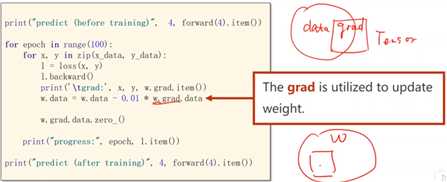
创建的w(权重)是Tensor类型,里面有w.data 和 w.grad
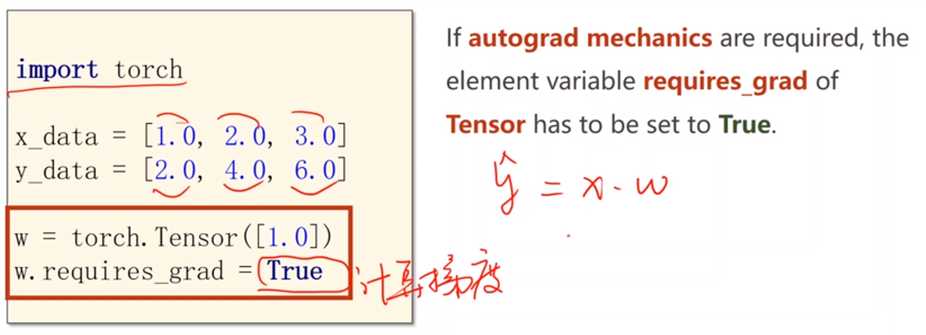
计算时用到了w,用到tensor的计算会构建动态的计算图,x*w也是Tensor了。
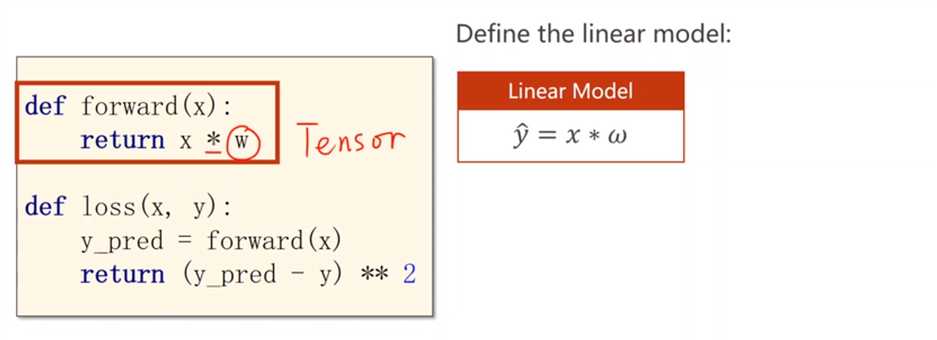
返回loss,调用backward的时候自动计算grad,存在Tensor里。计算图会释放,下一次进行loss计算会生成新的计算图。
更新权重的时候不能直接操作w.grad,它也是一个tensor,而是取w.grad.data。所有的Tensor都要去data数据操作才行,否则就是构建计算图。
清零梯度数据,否则下一次计算的梯度会和之前的梯度叠加,手动。
nn.Module 构造自己的神经网络
loss 构造损失函数
sgd
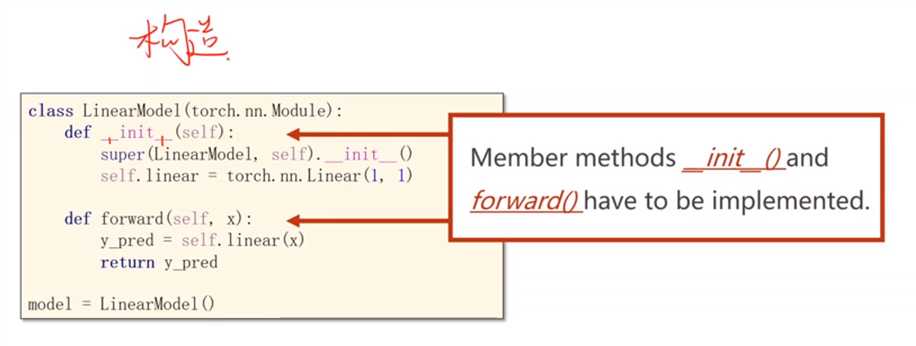
一定要有这两个函数(实现,名字相同)
没有backward:有module的类会自动实现backward这个过程
torch.nn.Linear(1,1) 是一个对象。包含w和b两个tensor
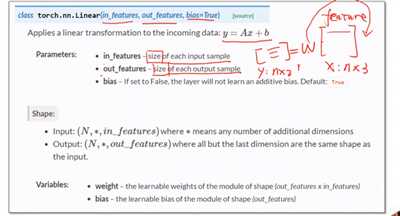
args和kwargs
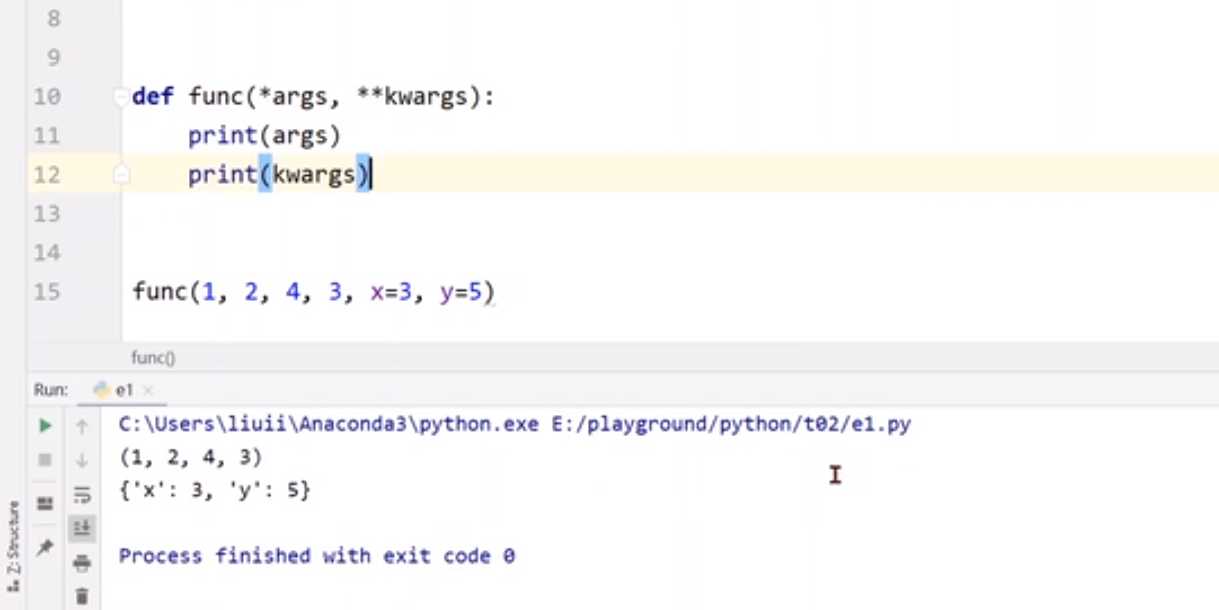
_ _ call _ _ 里面会调用forward,建立model初始化后调用model(x)就相当与把x直接传进forward里
MSE损失函数和SGD优化函数
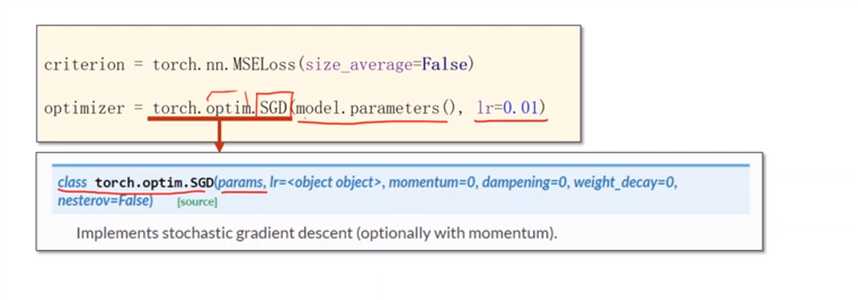
使用model.parameters得到模型本来定义好的w和b
训练的过程
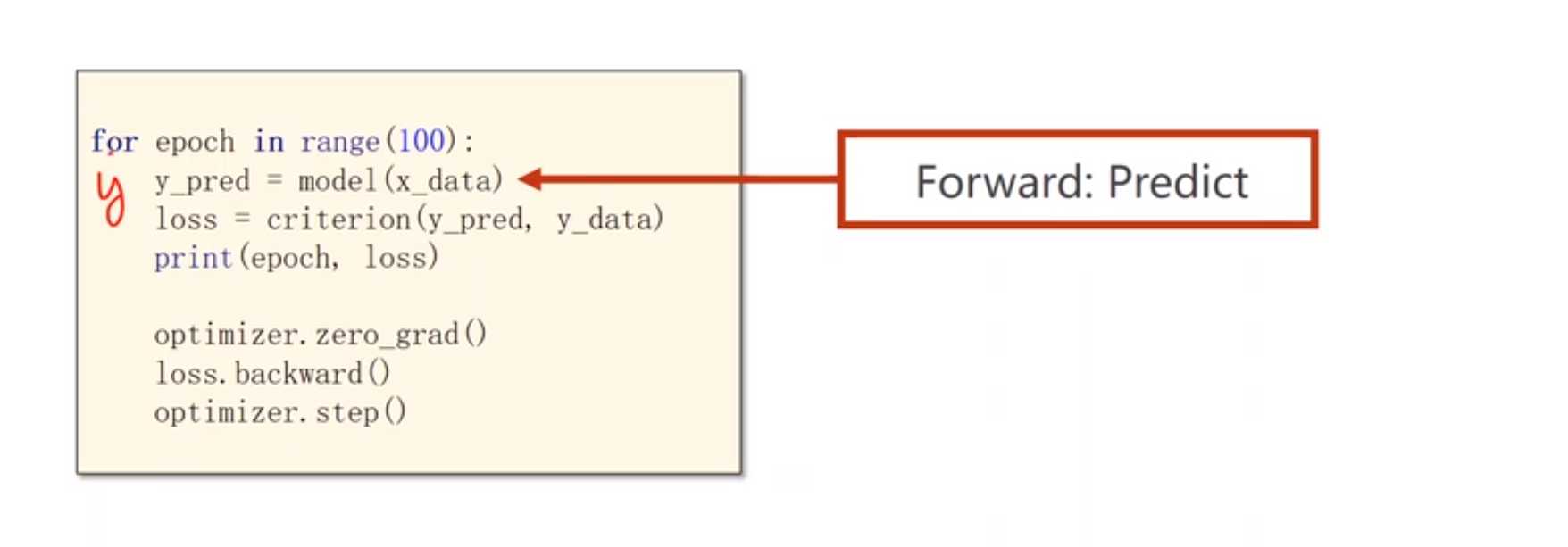
先计算出当前结果,然后计算损失,然后backward,最后更新
各种优化器
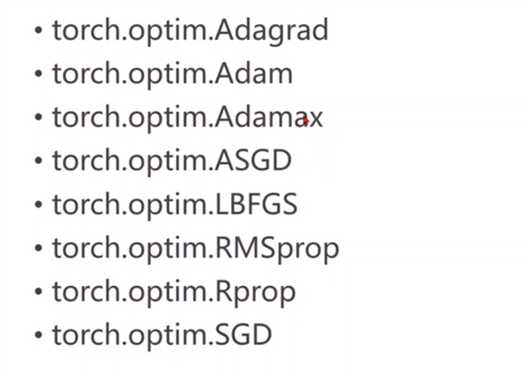
LogisticRegression解决分类问题

Sigmod函数定义在functional包下
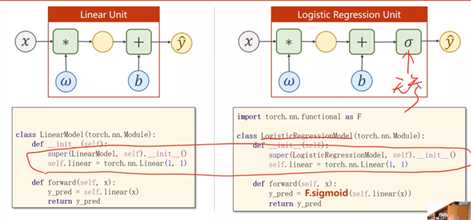
基本分块,Cross EntropyE计算loss
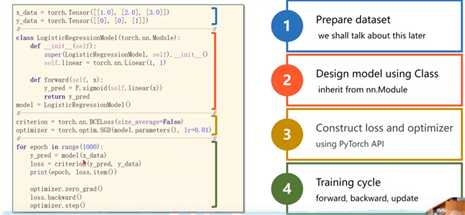
原文:https://www.cnblogs.com/pppqq77799/p/13537923.html